Lesson 12 (2)
POCKET CONCEALMENT:
Put right hand into right trousers' pocket and push the three cards into the upper corner. Hold them there a moment with thumb. Figure 23.

With tips of fingers bring out the pocket. You will find that pocket can be drawn out and shown empty even when there is something in it. Figure 24. Replace pocket.
NOTE THE USE HERE OF EMPHASIS. You requested spectator to reach into pocket. He found that it was empty. Now you pull out pocket and show it to be empty. The audience is in this way convinced that you have nothing in your pocket.
"I will now recount the cards to make assurance doubly sure."
FALSE COUNT the nine cards as twelve. Refer back to the first effect in this lesson for explanation of false counting.
Count the cards one at a time aloud. ALWAYS HAVE BACKS OF CARDS TO AUDIENCE in this form of false counting. There is danger of detection if the audience can see the faces of the cards for they are likely to notice when the same kind of card remains in sight for two counts.
"Twelve cards."
Hold the packet in left hand, backs of cards to audience.
Your left hand is extended and your right side is turned toward audience. Figure 25.
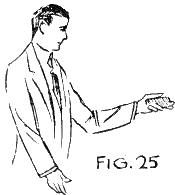
"What I propose to do is to cause the cards to pass one at a time UP my sleeve and down into my right trousers' pocket."
With right hand draw an invisible line from left hand along sleeve and down to right pocket -- merely touching outside of pocket.
"All I have to do is to click the cards and they will pass up my sleeve. This is quite similar to the way I vanish an elephant or a big bowl of goldfish and water up my sleeve. Sleeves are quite handy. If I want to produce a lady I merely shake my sleeve and a lady assistant appears. If I wish to vanish her, I say 'Hocus Pocus' and she vanishes up my sleeve again. Now, watch closely
and perhaps you can see the cards go. ONE --"
Click cards with left thumb. Show right hand empty, fingers wide apart and palm of hand to audience. Reach into pocket with right hand and take out one of the cards. Throw it on nearby table or chair. Figure 26.
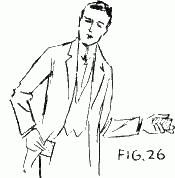
"Did you see it go? (Click cards.) There goes another. TWO --"
Reach into pocket after showing right hand empty. Throw second card on table.
A few spectators may have heard of palming and may think that you palm the cards in some way so whenever you can do so, show right hand empty before reaching into pocket.
"I hear someone saying to himself, 'I wonder whether those cards really do go up his sleeve and into his pocket.' Let us see." FALSE COUNT the nine cards as ten.
"Two from twelve leaves ten. You see two cards have passed. Now again. (Click cards.) THREE --"
Count cards out slowly so that all will be thoroughly convinced that you have nine cards.
Fan cards again as you did in the beginning of the effect. Close fan and insert little finger of left hand to separate six cards from remaining three.
"I will ask the gentleman here to reach into my pocket himself to see whether the third card is there."
Turn your right side to audience. As spectator reaches into pocket, place right hand over cards again, PALM THE SIX TOP CARDS in right palm. With tips of fingers of left hand turn up the three cards with faces toward audience, using thumb and first finger of right hand as pivot. Figure 27.
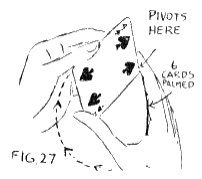
The effect is that you have transferred packet of cards to right hand and turned it over so that audience could see face of bottom card. Audience is absorbed in watching spectator who is reaching into your pocket and may not even see this move at all.
When spectator removes third card from your pocket, take three cards in left hand again and reach into pocket with six cards palmed in right hand.
Repeat move of pushing cards into upper corner of pocket, holding them with thumb, and pulling out pocket to show that it is empty.
"You are sure, sir, that there was nothing else in my pocket?" Gentleman responds, and you push pocket back again.
"Now watch again. (Click cards with left thumb.) Up the sleeve goes the fourth card and here it is in my pocket."
Remove a card from pocket and place on table.
"Next."
Click cards. Then reach into pocket and PALM one card.
"I thought it went into my pocket but I guess it didn't."
Bring right hand out of pocket with palmed card and place hand behind left knee. Be careful always to have back of hand to audience when you are palming cards.
"It seems to have traveled down behind my left knee."
Turn hand over and bring card out, holding it by thumb and tips of fingers of right hand. Figure 28.
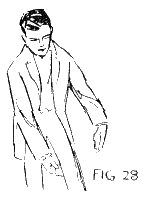
This effect of apparently reaching up with tips of fingers and thumb bringing out a card is an important one. Practice palming a card, moving it about to various places, and then suddenly getting it to the tips of the fingers and thumb and
suddenly producing it. By pressing card against some surface, in this case, the knee, you will have no difficulty in getting it from your palm to the tips of your fingers.
"They wander around sometimes."
Click cards. Reach into pocket and take out another card. Place it on table or chair.
"That one went all right."
Click cards. Take another card from pocket and place with the rest on table or chair.
"Up the sleeve and into my pocket."
Click cards. Reach into pocket, palm card, and bring hand out.
"That's funny. Oh, I see it got stuck at my elbow."
As you say this, reach up behind left elbow and bring out palmed card with finger tips and thumb of right hand. Place card on table.
"They get stuck in the joints occasionally. How many have we left?" FALSE COUNT the three remaining cards as four.
"One - two - three - four. Four cards remain."
Click cards and then count the three cards slowly as three.
"Please reach into my pocket and remove the card."
Assistant reaches in and takes out the remaining card in pocket.
"We now have three cards left."
SELF-CONTAINED CARD VANISH:
Show cards separately and then square them up and hold them in left hand with faces toward audience.
Hold them as shown in Figure 29. Click cards again.

With right thumb slip the first card down away from the other two. Hold the remaining two cards in left hand tightly as one. Figure 30, next page.
"One card."
Place the two cards held as one on top of the first card. Hold tight with right thumb. Snap cards with fingers of left hand as you put them down. This makes it appear that you have only two cards. Fig. 31, next page.
"Two cards."
You have apparently vanished a card.
Square up cards perfectly so that the three will look like one card and hold them in left hand.
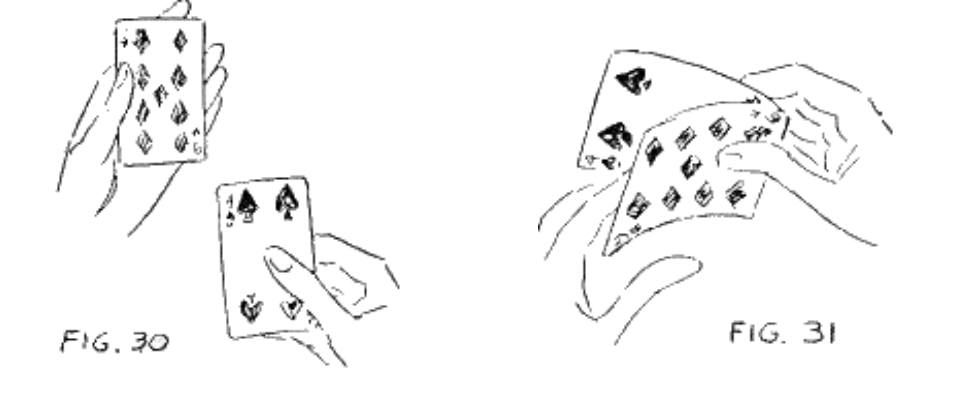
Snap face of card with right second finger.
"Pass."
Turn cards over as one card and snap them on the back with finger.
"One card left."
The snapping back and front emphasizes the effect of holding only one card.
In my work I actually throw three cards from right to left hand and they do not come apart. You will find many uses to which you can put this principle of showing three cards as one. As you study, new ideas may present themselves to you for using this principle. "Now the last card."
BACK TO FRONT HAND CARD VANISH:
Place the three cards as one with backs to audience on the back of right hand. Grasp edges under first and last fingers at about the second joints. Fig. 32.

Pass left hand over cards on back of right hand. Fig. 33.
As you do this, turn fingers and cards down into palm of right hand. Bring out second and third fingers, then straighten all the fingers. Fig. 34.
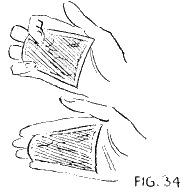
As left hand leaves right hand, it should be kept closed as if it had taken card from the right hand and closed around it. Cards are now concealed in palm of right hand. Fig. 35, next page.
Bring left hand about eighteen inches away from right and open it slowly to show that card has disappeared.
Place right hand in right trousers' pocket and bring out the cards one at a time.
"One - two - three."
Note -- Learn to do this effect also without having gentleman reach into pocket. In stage work a spectator may not be near enough — or it may not be advisable to use a committee.
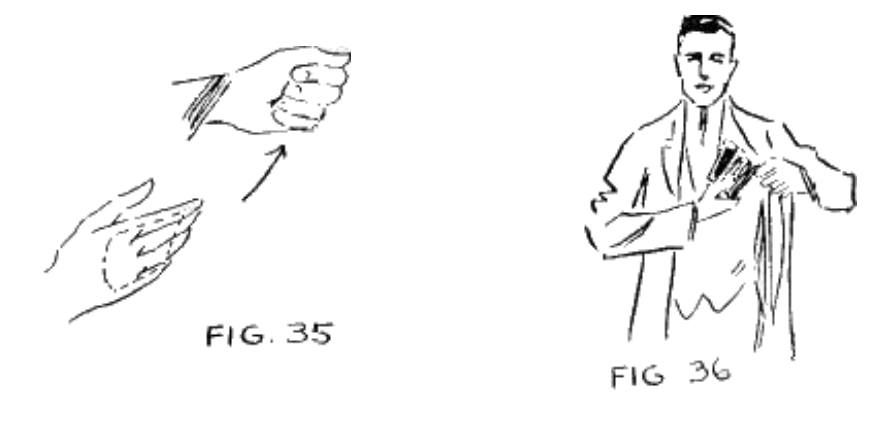
VARIATIONS:
The preceding effect may be presented in a little different way.
Before you begin the experiment place two cards in your upper left vest pocket, faces toward your body. Then while you are performing and have passed about six cards to pocket, click a card and pretend that it did not go into pocket. Start looking for it and reach up under coat with right hand. Take the cards from vest pocket quickly and carry them up under shoulder. Grasp left side of coat with left hand and open coat. Bring out the two cards fanned out, backs to audience. Fig. 36.
"That time two went up together and, as a result, got stuck at my shoulder. Let them now continue on their way."
Let go of coat with left hand. Reach up under left side of coat with right hand and quickly put cards back into upper vest pocket. Then move hand up to shoulder so that audience can see coat lifted, giving the impression that you placed the cards there.
"One - two -- there they go. And here they are."
Reach into trousers' pocket and take two cards out. Then continue effect as described above.
Another variation of the effect involves some preliminary work. Have the lining on your left coat sleeve opened and pocket sewed in large enough to hold several cards. On the edge have a snap fastener sewed on. Fig. 37.
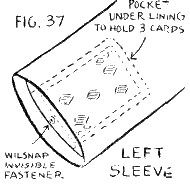
Before appearing for your performance place two cards in pocket of sleeve. After having passed several cards, pretend that cards got stuck in sleeve. Reach up sleeve with right hand, open snap, and take cards from pocket. Fan the two cards, backs to audience. Then say that they will continue on their way. Reach into sleeve again, replace cards in pocket of sleeve, close snap. You can now show empty sleeve to prove that cards have vanished.
Then produce the two cards from trousers' pocket.
Little stunts like these add Showmanship to a trick and make it more interesting.
EMERGENCY METHOD:
If you should happen to be before a group, some of whom have seen you perform this experiment before and think you use palming, it is best to vary the effect in the way I shall describe here. These spectators are watching you closely and you must leave them completely mystified at the end of the experiment.
Slip three cards into your right trousers' pocket beforehand. Then instead of counting off twelve from the deck, FALSE COUNT nine cards off as twelve.
Show pocket empty by method I described above. Start clicking cards. The sharpest eye cannot see the cards go into the pocket now, for they are already there.
Another ruse is actually to count twelve cards from the deck or to have someone else count them, then to palm off six and replace them on top of pack in squaring up the pack and placing it on table. Have six cards in pocket before you start.
4. CARDS UP THE SLEEVE
(The Shoulder Method)
This is a pleasing variation of the CARDS UP THE SLEEVE effect. Instead of producing the cards from the trousers' pocket they are produced from under the left side of coat at the shoulder.
EFFECT:
Twelve cards are counted from the pack and placed in the left hand. Performer causes the cards to pass one at a time up his left sleeve and takes them out from under the left shoulder of his coat.
PARAPHERNALIA:
1--Deck of Cards.
SECRET AND PATTER:
To Perform:
Have twelve cards counted from deck and hold them in left hand, separating top three cards ready for palming in right hand.
PALM OFF the three cards in right hand and drop hand a little at side.
"Before beginning this odd experiment I want to tell you about a magician's sleeves. This one has two ends, one at the bottom (point with right hand to bottom of sleeve) and an end at the top."
Grasp left edge of coat with left hand and make a gesture with right hand to show upper end of sleeve, placing hand on left shoulder. Drop left side of coat. This screens right hand and the palmed cards. Leave cards on upper part of left shoulder. The weight of the coat will hold them securely in place. Audience is not aware of your real move. It appears that you were merely explaining the sleeve. Fig. 38.
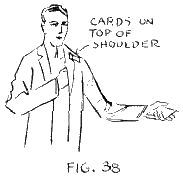
"There have been many stories told about magician's sleeves and how things go up and down them. Of course, a sleeve is the only place where a
magician could conceal anything, especially a couple of lions, a tiger, a dozen rabbits, a billy goat, a couple of girls, and a barrel of pickled herring. The real problem, however, is 'Just how does the magician cause the various objects to pass up and down a sleeve?' I will explain by causing these cards to walk up my sleeve one at a time. First, we have twelve cards."
FALSE COUNT the nine cards as twelve.
"I will place them in my left hand and when I click them, up will walk a card into my sleeve and travel upwards."
Click cards in left hand.
"Did you see that one go? A little too fast, was it? Well, here it is."
Show right hand empty, fingers wide apart. You must convince audience that you have nothing in your right hand. Reach up under left side of coat and take ONE card from shoulder. Show it plainly. Place card on table.
"One card. Up one end and out the other. Again!"
Click cards with left thumb.
"Up goes the second card."
Show right hand empty again and then take another card from shoulder.
"You see it is a sort of clickety click arrangement. Do they really pass up the sleeve? We shall see." FALSE COUNT the nine cards as ten.
"Ten cards left. The two have gone. Now watch the cards just as closely as you can so that you will see one jump from the packet in my hand out and into my sleeve." Click card.
"See that one jump? Here it is." Take third card from shoulder.
Count nine cards as nine.
Fan cards a bit, then square them up and get little finger under top six cards. Palm the six cards in right hand, then place the three remaining cards in right hand. Refer to Figures 19 and 20.
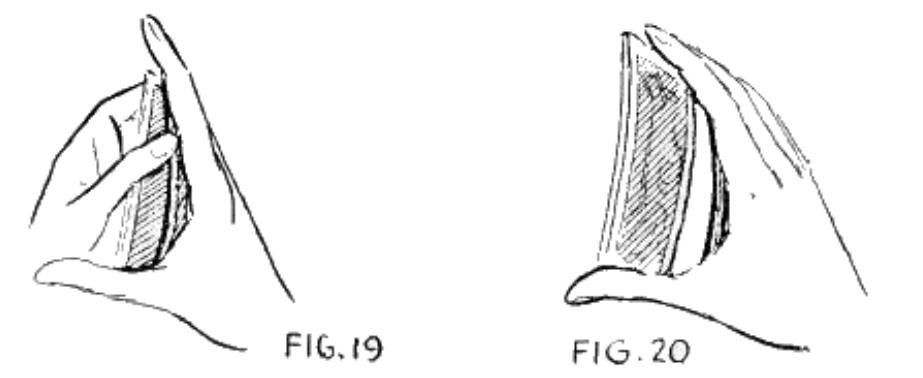
Audience believes these three cards to be nine. They do not suspect that you have cards palmed.
Place the three cards in left hand again, click them, and reach right hand up under coat to left shoulder. Place the six cards on shoulder. Take one card out with a quick and snappy movement.
"That's a speedy fellow."
Now produce the next five cards one at a time, varying the manner of producing perhaps two of them.
Reach up under shoulder and pretend that you failed to locate the card. In reality, palm one of the cards in your right hand. With left hand lift left edge of vest, reach up under it with right hand, and bring out card by thumb and finger tips, as you did in the production at the knee.
"That one went so hard it lit down under my vest."
Another time, palm card from shoulder and produce it from right coat pocket or from bottom of left trousers' leg.
"These are getting to be regular sky-rockets."
Produce cards until only one is left at shoulder and you have three in left hand.
Count the three as four, then click cards and take another card from shoulder. Now count the three cards slowly as three.
TO VANISH THE LAST THREE CARDS:
This is a most important move and one which can be used in many effects to vanish a number of cards. With practice you will perfect this move and become skilled in its use.
The effect is that you just push the cards into left hand which closes on them. Then you open left hand -- and the cards have vanished.
PIVOT CARD VANISH:
Place the three cards in left hand as shown in Figure 39. This is the way it looks to the audience.
Push cards into left hand with right fingers, edges of cards just at second joint of right fingers. Figure 40.
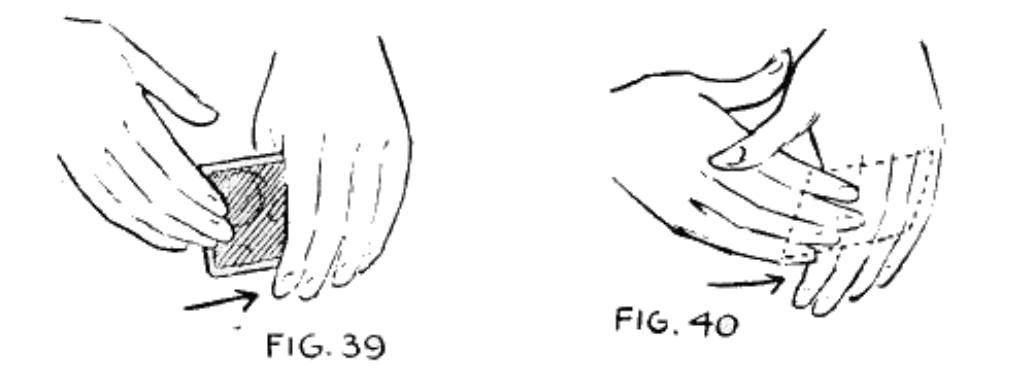
When cards are almost all in left hand push tips of right fingers forward. This causes card to pivot on first finger of left hand and to revolve automatically into the right palm. Bend right hand slightly and palm the cards. Fig. 41.
At the moment when cards are propelled into right hand, close left hand as though cards are in it. Lift left hand up, constantly looking at it. Remember your MISDIRECTION here -- not to look at right hand at any time when you have cards palmed in it. Figure 42.
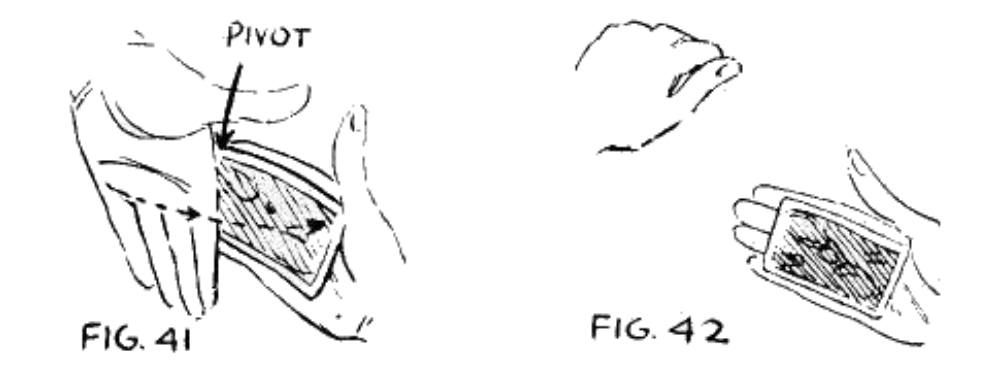
Open hand slowly and show that cards have vanished.
Now place right hand suddenly into right trousers' pocket, push palmed cards into upper corner of pocket, and bring pocket out empty. Then pull left pocket out empty. Look perplexed as though you do not know where the cards are. Push the pocket back in again. Reach up under coat to left shoulder, then feel around vest for them. Give your vest a shake as though you are shaking something down. Then suddenly reach into right trousers' pocket again and remove the three cards.
Or right hand can be pushed under left side of coat and cards produced from shoulder.
Lesson 13
In the next lesson we continue to study card effects -- this time some very interesting card stabs. With the effects, of course, you learn some more essential principles of Card Magic.
1 -- A deck of cards is divided into two parts. A card is selected from each half by a spectator, remembered, replaced, and shuffled into its respective half deck. The two packets are put together to form whole deck again. The deck is placed behind a piece of newspaper. A spectator stabs through the paper into the deck of cards with a knife. Paper is removed. Deck is opened at place where knife pierced it and it is found that the selected cards are there, one on each side of the knife.
2 -- Spectator selects a card from deck. This card is shuffled back into the deck. The cards are wrapped securely in a piece of paper. Spectator is then given a knife, which he stabs through the paper into the cards. Performer removes the paper and it is found that the knife has located the selected card.
3 -- A card is selected, then thoroughly shuffled into the deck. Spectator runs knife into deck anywhere he chooses. Cards are separated and it is found that the selected card is at place where knife was inserted.
TARBELL SYSTEM, INCORPORATED, Chicago.
Bạn đang đọc truyện trên: truyentop.pro